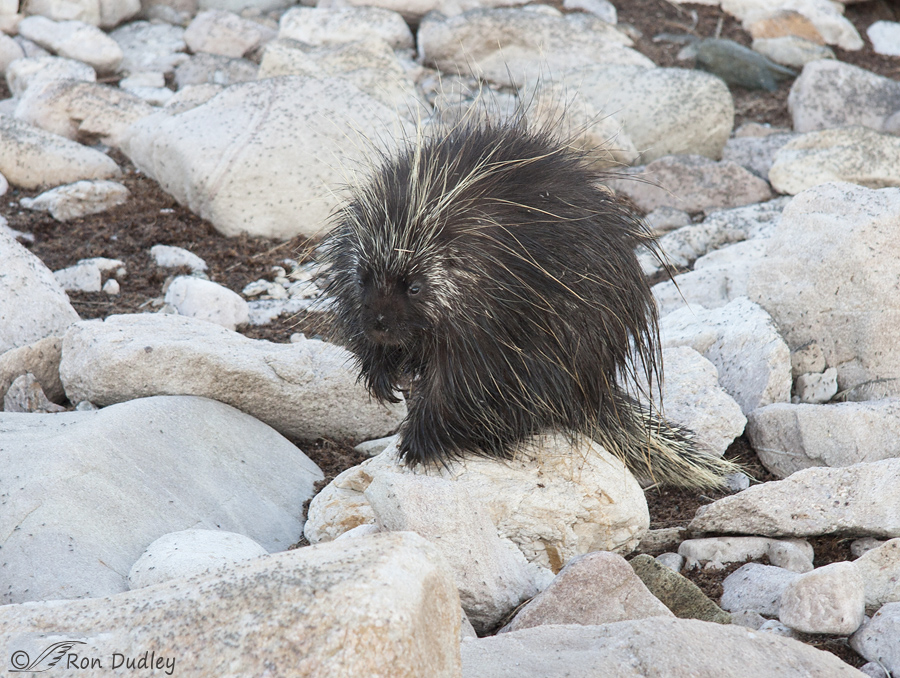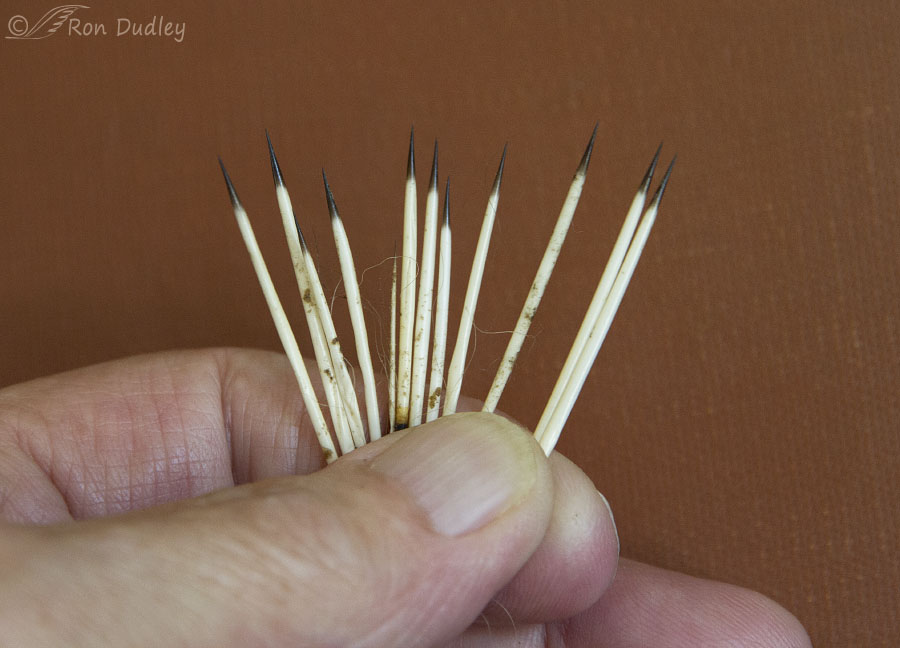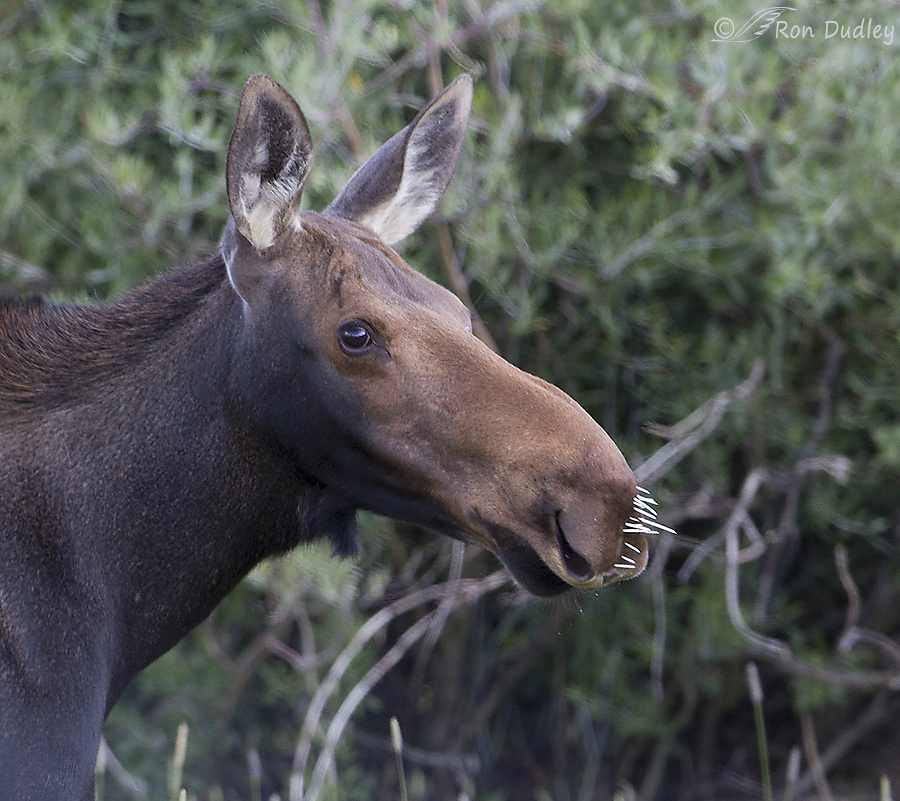“Don’t mess with Porky” was one of the early lessons I learned growing up on the Montana farm.

The North American porcupine is our second largest rodent after the beaver. They can approach 40 pounds in weight athough most are smaller. I photographed this one some years ago on the causeway to Antelope Island.
Most everyone knows the misery porcupines can cause for man or beast when they’re not treated with respect. They’re not aggressive by nature but when they feel threatened they’ll willingly defend themselves with their fearsome quills.
One of my early memories on the farm was of a neighbor’s horse that had been quilled in its pasture and the methods farmers and ranchers used in those days (early 50’s) to extract the quills were pretty primitive. No veterinarian was called and believe me, it wasn’t pretty. The muzzle of a horse is extremely sensitive to begin with and this one probably had over a hundred quills in it. I’ll just say the restrained horse was terrified and in great pain with every extraction. I was just a young kid at the time and the memory (and the sound) is still seared into my brain.

And these are the source of all that misery. I took these quills from the dead, stinky porcupine at the “porcupine bush” where I’ve been photographing birds for the last few weeks. Quills are modified hairs and each porcupine has about 30,000 of them covering their entire body except for their underbelly, face and feet. They’re incredibly light, so light you can’t even feel the weight of a bunch of them in your hand. And each quill has 700-800 tiny one-way barbs at its tip that make the quill much more difficult (and painful) to pull out of the victim than was required when they went in.
Scientists have recently discovered that porcupine quills are much sharper than we thought they were. Following is a description of their research results from the online site “Science”. It’s a bit lengthy but I highly recommend it. I think it’s fascinating, partly because the results were so unexpected.
- “The researchers took barbed porcupine quills and plunged them into samples of pig skin, measuring how much force it took to pierce the flesh and then how much force was required to extricate the quill. The team then performed the same tests using quills whose barbs they had sanded off. They also tested an African porcupine’s quills (which naturally have no barbs) and an 18-gauge hypodermic needle, which is approximately the same diameter as a quill from the North American porcupine.
- To the scientists’ surprise, barbed quills required approximately half the penetration force of the barbless quills—either those naturally barbless or those sanded clean—and only 56% of the force needed for the hypodermic needle to breach the skin. Computer models suggest that the barbs ease the quill’s penetration by concentrating force along the edges of the barbs, similar to how the serrations on a knife blade make cutting meat easier.
- Barbs render a quill about four times harder to pull out once they’re embedded, the team found. The barbs at the tip of the quill were most effective at resisting removal. In fact, the barbs located within 1 millimeter of the tip contributed about half of the pull-out resistance—possibly because the flesh more tightly surrounded the tip than it did the rest of the quill.”
While I was trying to arrange the quills in my fingers for the photo above I tried to be very careful but I stuck myself several times and they didn’t come out of my skin easily. If they had gone in deeper than just my skin I can only imagine how difficult they would have been to pull out.
Several years ago I photographed this cow moose in the Uinta Mountains. From a distance I thought she was trying to eat something white because I could see her tongue maneuvering around the “white stuff” but through my lens it was instantly obvious that she’d been quilled. The poor cow had many days of misery ahead of her before her body would dissolve the embedded parts of the quills. One danger is infection but there’s another. If the quills are embedded in areas of loose skin (such as the neck of a dog for example) the barbs sometimes make the quills move deeper into the body with very serious consequences. After this photo was taken I was somewhat relieved to see her browsing in the willows – she was actually able to eat.
One last porcupine story. My uncle Floyd and family (their farm adjoined ours) had a smallish white dog named Toby who was what I called a “grouchy sumbitch” and that was when he was having a good day. When he wasn’t he could be truly nasty, although I always had a soft spot for him. Toby was small but fearless and a relentless killer of “gophers”, skunks and even the occasional weasel when he could catch one and he showed no hesitation with porcupines – he just plowed right in and took them on. Needless to say we had to pull quills out of him more than once.
With Toby there was only one way to do it. Floyd had an old piece of stiff, discarded carpet that he kept for just that purpose, When we could finally catch Toby (he knew what was coming) it took three of us to roll him up tightly, very tightly, in the carpet with only his face sticking out. Then one of us would grab the pliers and we’d start pulling them out. Believe me that was one pissed off dog!
When it was over we sometimes didn’t see him again for days, though his food always disappeared from the porch. But eventually he always forgave us in his own time and in his own Toby way. To this day I always think of him as a little white grizzly bear.
Ron
PS – If you’re interested here’s a link to an older post I published about a porcupine incident involving author Terry Tempest Williams and myself.



Sorry to be a day late on this one, but I have extensive experience with porcupine quills AND cactus needles. Reba the Silly Bird Dog never met a stranger–not even a porcupine. For her trouble in making friends, she got a snoutful of quills. That wasn’t fun, nor was it fun when she tried to eat the prickly pear cactus to get to the rabbit inside! That one took a vet and a couple of hours to remove MOST of the big and little needles from her snout, lips, gums and tongue. She was a MESS! Thankfully, she learned to give cactus a wide berth, but she met three more porcupines with the same result.
There’s also the artistic part of porcupine quills. Porcupine quill embroidery is beautiful. My best friend made a leather medicine bag for me, embroidered with quills with the Osage spider on the front and it’s just beautiful! But I hear it’s a tedious art.
It is most interesting to know that the body (in this case the moose’s body) would end up dissolving the porcupine quills. Around here we have problems with glochids, the small orange spines on prickly pears, which apparently have a fishhook end, and are extremely difficult to remove. Actually, we had someone who was crazy enough to be wearing shorts at the park be part of one of our tours, who ended up with glochids in her leg. We got some of them pulled out, and I hope the remaining ones didn’t hurt too badly until she got them out or they dissolved.
Susan, I read that they’ll eventually dissolve on a veterinary blog so I’m fairly confident it’s the case. In the meantime infection would still be a potential issue though.
Someone told me the quills are easier to remove if you snip the ends off “to let the gas in them escape”. Is this true??? The only ones I ‘ve seen have been slow moving, curious and not at all aggressive…They are actually pretty cute…
Patty, I’ve heard that theory before too, but it isn’t true. And just last night I read a veterinary blog that reinforced that view. Similar to the old belief that porcupines throw their quills, they don’t.
My encounter with a porky was second hand…or second butt..On a backpacking trip with 17 HS seniors, one of the girls sat on a log filled with quills..I sent the boys on ahead to wait, got her to pull down her pants and with the tweezers on my trusty Swiss Army knife, was able to remove the quills from her clothing snd her poor backside…we were all much more cautious after that…
The sound I dreaded most in wilderness areas, like the mountains, was the “Unh! Uhn! Unh!” of a porcupine circling my tent..looking for something to eat, especially something salty…like my boots, which (thank god!) I was always careful to bring inside at night…chewed up boots could be a real disaster!!!
Patty, I’ve had similar experiences with kids on field trips, but with cactus spines rather than quills.
They’re famous for eating axe handles to get at the sweaty salt in them.
Ouch. For everyone affected, whatever the species. But particularly for those with no opposable thumbs to pull those quills out. Loved the early story too.
And have a huge weakness for summabitch characters (like calling to like?).
“But particularly for those with no opposable thumbs to pull those quills out”
Very good point, EC!
I used to work in a wildlife rehabilitation center. We had a collection of unreleasable animals on display for the public. These critters were quite socialized to humans – among others, a turkey vulture who vomited when she was anxious and needed a soft voice to reassure her, a demanding kestrel (I need a cricket now! Where is my pinky mouse!) and a porcupine. The porcupine was clever, curious, friendly, smart, and loving. One day when I was feeding her she made eye contact, leaned forward, wrapped her arms around my neck and pulled me in and hugged me, making wonderful talkative sounds. Her fur down to the quills, which began at her shoulders, was soft and deep and velvety. So I’ve been hugged by a female porcupine and it was wonderful. Make of it what you will. Carefully. Very carefully.
Loved your porcupine story, Martha. A perspective we never see or even think possible.
Oh Martha. WHAT a privilege. And an honour.
What a wonderful lesson for us…kindness is always rewarded. You certainly made a loving connection with her.
Very interesting…always great to learn something new. I haven’t seen a porky in this area of Wisconsin (NE) in the 20 + years I’ve been here. I know they are further north. Growing up in the far north of Michigan was a different story…the beagles many times came back from rabbit hunting with quills in the snout. What a mess to remove…but as usual you just can’t teach an old dog not to stick their nose where it doesn’t belong!
Thanks, Kathy. In my experience some dogs learn that lesson but many don’t.
The eyes on that porcupine look so harmless and placid. I guess it can afford that look. One day while working at a veterinary clinic I took a photo of a “quilled” dog and hung it up with the caption: “So you think you’re having a bad day.” It helped to look at that pitiable mutt when dealing with difficult animals (or clients).
Their eyes always get my attention when I can see them, Lyle. But unless there’s direct light on them they’re difficult to see, including in photos.
That was a creative way to use that photo you took.
Great post Ron! Poor moose, that’s a snout full.
Charlotte
Thank you, Charlotte.
Yes Ron! As a veterinarian I’ve seen too many dogs come in after being quilled. In the Veterinary ER, in the summer in New Hampshire, it was the same routine every night. Just after dark owners let their dogs out for one last potty break, off leash, and they would come back with face and paws filled with quills. After sedating the dogs we find quills throughout the dog’s mouth and gums. You are exactly right – those quills will move and get embedded in different areas if they aren’t removed, and infection will set in. And the pain is horrible. An all around bad situation for the dog, owners, and vet staff starting the night shift!
I can imagine how challenging those nights are for vets, Carol.
I was always surprised that Toby apparently never learned that the price he had to pay for attacking both skunks and porcupines was just too big. He was a smart dog about some things but not about others.
One night Toby had a skunk cornered on the front porch when we came home in the dark. We had a hard time getting into the house…
Very interesting post Ron. Thanks for the porcupine education. My wife watches all those veterinarian shows such as Dr. Pol, etc. Very often one of the shows will have a dog or horse who got too close to a porcupine and now need to have multiple quills removed.
Everett Sanborn, Prescott AZ
PS: when I type in my name and e-mail it no longer auto fills after typing in the first letter – I have to type in the full name and e-mail address – not a problem, but just wanted you to know
Thanks, Everett. Not sure what’s going on but I appreciate the heads up.
Fascinating stuff. Especially about the research on the barbed quills.
I’m glad you thought so, David. So do I. Thank you.
Interesting creatures until you have to deal with their “handy work” Some dogs will tolerate having the quills removed and some go berserk and have to go to the vet! Had one of those who went under fighting and came out the same way…:( Joe (hubby) accidently got one in his arm laying on the ground – they do go in easy and come out hard!
Some dogs will tolerate having the quills removed and some go berserk and have to go to the vet! Had one of those who went under fighting and came out the same way…:( Joe (hubby) accidently got one in his arm laying on the ground – they do go in easy and come out hard!  Have had a couple of beautiful “blond” ones around here now and then. They are also terribly destructive to some trees/shrubs during the winter here.
Have had a couple of beautiful “blond” ones around here now and then. They are also terribly destructive to some trees/shrubs during the winter here.
I’ve yet to see a dog “tolerate” quill removal, Judy. Toby sounded like a cross between a banshee and a Tasmanian devil while having quills extracted and we sure tried to avoid his teeth. Don’t remember anyone ever being bitten though so maybe it was all threat. I miss that dog and he wasn’t even mine.
You’re worried about getting the best shot — and I’m worried about you hurting yourself.
Who’s that was supposed to be a reply to your reply.
Love these porcupine stories and the interesting info about quills ect. This blog is always a pleasure to read!
Thanks very much, Joanne.
Informative and poignant post, Ron. 700 to 800 one way barbs per quill? EGad! Animal lover that I am I feel so sad for the barbed horse your described as well as Toby and the cow moose. Of course, Toby asked for his misery but the horse and the moose were just curious. Hope you don’t suffer any lasting affects from your quill sticks. I had read that porcupine quills can stay in, fester and even work their way in deeper. Good to know that the moose could eat but wonder what happened later.
I’ve often wondered about that moose too, Melanie. Survival is tough out there…
Poor moose! Poor Toby! Poor Ron! (Thank you for braving the stinky porky, but why not save your skin and put the quills on the table for the shot? ) I was fortunate to have learned about quillwork from an Ojibwa Elder and yes, dealing with those things is no joke.
) I was fortunate to have learned about quillwork from an Ojibwa Elder and yes, dealing with those things is no joke.
As for those summabitch dogs, those tend to be favorites of mine because for some odd reason, they seem to like me. Go figure. Must be a “like dissolves like” sort of thing.
Marty, I wanted a closeup for good detail on the quills with an out of focus background so they stood out better. The best way to do that is to hold them further away from the background.
By the time I collected them the porky was no longer stinky. It sure was flat though…
I’ve never known a dog like Toby. He had an attitude that wouldn’t quit but I ended up admiring the hell out of him!